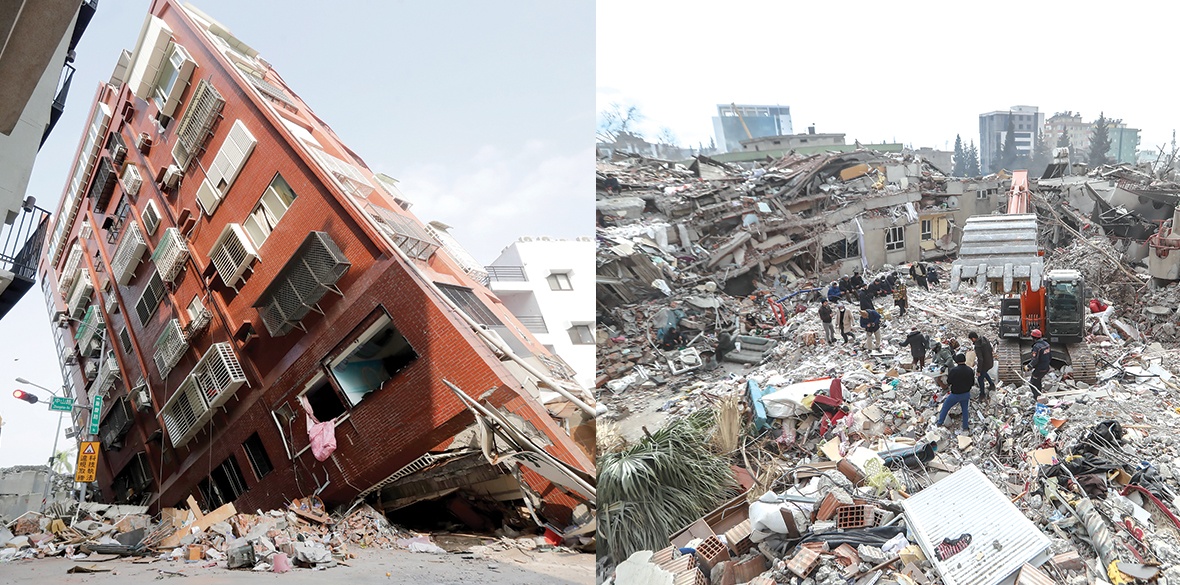This is the last article you can read this month
You can read more article this month
You can read more articles this month
Sorry your limit is up for this month
Reset on:
Please help support the Morning Star by subscribing here
IN a video taken just after a magnitude 7.4 earthquake struck the eastern coast of Taiwan on April 3, the Taipei 101 skyscraper is shown oscillating lightly. Despite the fact that tall buildings are particularly susceptible to seismic damage, the building only experienced minimal swaying during the earthquake.
Elsewhere in Taiwan, 28 buildings collapsed and at least 125 experienced some form of damage. It wasn’t simply luck that protected Taipei 101; the 1,670-foot tall building has been specifically designed to minimise damage from natural disasters that are endemic to the region, such as earthquakes and typhoons.
When an earthquake happens, its energy is dissipated in the form of seismic waves, which have a variety of frequencies (rates of vibration). These seismic waves cause the ground to shake.
Buildings have a natural rate at which they will vibrate, referred to as their resonant frequency, like the natural frequency of a child going back and forth on a swing. When seismic waves of this resonant frequency shake the ground beneath a building, the wave will be amplified, causing stronger shaking and more damage.
The ability to reduce the amplitude of shaking is known as “damping.” Taller buildings are more vulnerable to large earthquakes, because they have less ability to dissipate the energy of these seismic waves, tending instead to swing more and more wildly as additional resonant energy waves hit them.
Structural engineers designed Taipei 101 to be flexible and structurally resistant. Between the 88th and 92nd floors hangs a steel pendulum weighing 660 metric tons, which acts as a “tuned mass damper.” It has been specifically designed to have a similar oscillation frequency to Taipei 101’s resonant frequency.
The pendulum reduces the swaying movement of the building by itself swinging in opposition to the building’s motion. As well as the pendulum, the foundation of the building is reinforced by 380 piles driven 262ft into the ground, extending as far as 98ft into the bedrock.
Large earthquakes are natural disasters, and therefore will always have an element of unpredictability. The Earth is made up of constantly moving tectonic plates, which are responsible for mountain ranges, oceans — and earthquakes. As these tectonic plates converge and move past one another, they can get stuck due to friction.
Sometimes plate boundaries adapt to this by constant “creep” motion, releasing many small earthquakes relatively safely. However, in other areas, the plates might be locked in place for hundreds or thousands of years, causing strain to build up on a fault zone. This strain is finally released through the fault “slipping,” and produces high-energy seismic waves in the form of a large earthquake.
Through careful study and mapping of plate tectonic motions, scientists are able to predict how much strain is building up on a given fault. Looking at the structure of local geology can also reveal past earthquake events and provide information such as how much displacement was caused by a fault slipping previously. Although forecasting of major earthquakes has been improving, we still can’t say with complete certainty when a fault will slip.
However, a large earthquake does not have to herald widespread death and destruction. Properly designed infrastructure, clever building modifications, public education and well-prepared search and rescue teams can mean the difference between ten lives lost (as in the recent Taiwan earthquake) and tens of thousands of lives lost (as in Turkey-Syria’s 2023 earthquakes).
The 2023 Turkey-Syria earthquake doublet comprised a 7.8 magnitude earthquake near Gaziantep in south-central Turkey, close to the Syrian border, followed by a 7.7 magnitude earthquake almost 10 hours later. This was only a slightly larger magnitude than the recent Taiwan earthquake on April 4, but the effects were far more devastating.
They were the fifth deadliest earthquakes of the 21st century, with 53,537 fatalities in Turkey and between 5,951 and 8,476 in Syria. In total an estimated 14 million people were affected. The damage extended over huge parts of southern and central Turkey and northern and western Syria; the total area affected was around the size of Germany.
Comparing the consequences of the Taiwan earthquake to the Turkey-Syria earthquakes illuminates a stark difference. Taiwanese buildings, as exemplified by Taipei 101, are much more likely to be engineered for earthquake resistance — a requirement for any structure built after 1974. Highly trained search-and-rescue teams were also well-prepared to respond to the earthquake.
By contrast, the area affected by the Turkey-Syria doublet comprised built-up areas that had little seismic resilience. In particular, 15 hospitals in Turkey suffered partial or heavy damage, while 55 medical facilities in Syria were damaged, impacting their capacity to respond to the earthquakes and undoubtedly contributing to the high death toll.
A field report by the Institution of Structural Engineers Earthquake Engineering Field Investigation Team found that building stock was primarily made of Reinforced Concrete structures, which they concluded was the main cause of the high rate of casualties. (We wrote previously about the concrete industry’s pervasive influence in the aftermath of the earthquake.)
Researchers from the team commented that the drive for profit entices the construction industry to take shortcuts, meaning that even with established building regulations and codes, non-compliant buildings are still being constructed in the region.
Deficiencies were noted even in the newest buildings, permitted by repeated “amnesties” from the Turkish government which allows non-compliant buildings to remain standing and protect the construction companies that put them up.
Seismic resilience is not only an engineering problem but one that is deeply linked to the political and economic context of Turkey and Syria. Both of these countries have experienced severe economic crises over the last decade.
In Turkey, the lira has plunged in value, combined with high inflation, rising borrowing costs and loan defaults. Syria has been under severe economic sanctions from Western countries since 2011, which has devastated its economy and led to hyperinflation.
Decades of US-backed efforts to destabilise Syria through warfare and sanctions have also led to the forced displacement of millions of Syrians and the destruction of one-half of healthcare and education facilities. All of these are contributing factors to the difficulty of responding and preparing adequately for a natural disaster.
The comparison between Taiwan and Turkey-Syria is just one example of the global differentiation in disaster response. As Michael Parenti famously said, “Countries aren’t underdeveloped, they’re overexploited!”
While the global North continues to monopolise and extract resources from the global South, as well as actively foment war, earthquakes will continue to cause extreme destruction in these overexploited regions.
This is not an inevitability. Every country could, and should, have access to technology, infrastructure and educational materials to prepare themselves and mitigate the harmful consequences of earthquake events.










